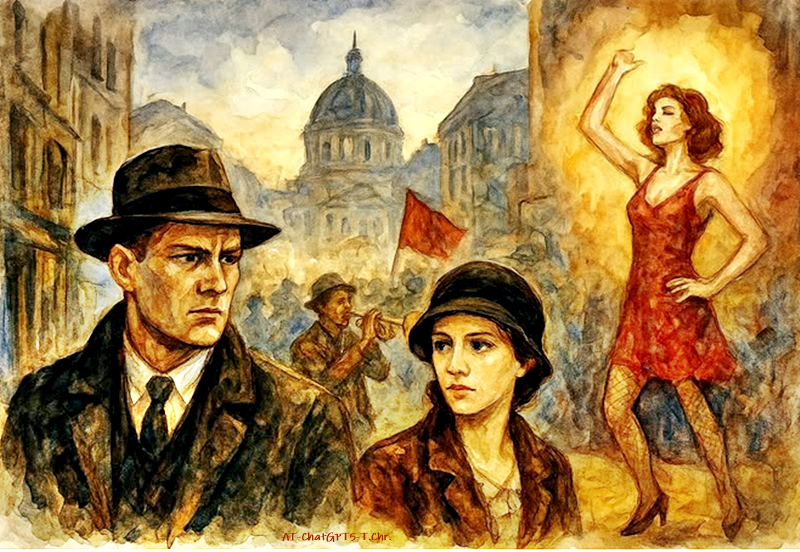A TASTE OF BERLIN.

By AI-ChatGPT5-T.Chr.-Human Synthesis-25 September 2025
Berlin, 1929. The city is restless, a fever that cannot be cooled. Neon signs flicker above crumbling tenements, jazz horns scream into the night, and the Weimar Republic trembles between excess and collapse — intoxicating in its freedoms, but terminally ill.
It is into this maelstrom that Gereon Rath arrives, a detective from Cologne sent to investigate a blackmail scheme tied to an underground pornography ring. On paper, the mission is clear. But Berlin does not obey paper rules. Its streets coil and mislead, its alleys conceal more than shadows, and its institutions rot from within. Rath is already a fractured man. The trenches of the Great War have left him scarred, his conscience gnawed by memories that morphine alone can quiet. He clings to the discipline of police work, but the ghosts of the past stalk him, waiting for silence to fall.
In Berlin, silence is rare. Charlotte Ritter knows this truth better than most. By day, she is a stenographer at police headquarters, sharp-eyed and quick-fingered, overlooked by the men she serves. By night, she moves through cabarets and slums, a survivor navigating the city’s shifting currents. She has known hunger, violence, and invisibility, yet she dreams of breaking into the male-dominated world of criminal investigation. Berlin, to her, is both an obstacle and a proving ground. Her resilience makes her dangerous; her ambition makes her unstoppable.
Their paths converge when Rath’s investigation begins to unravel. The pornography ring is not merely about smut and shame — it touches nerves of power, threading into crime syndicates, police corruption, espionage, and the quiet deals of industrialists who shape politics with invisible hands. Files disappear, witnesses vanish, and each discovery Rath and Ritter make only opens darker corridors of conspiracy. Berlin itself seems to resist being understood. Events on the streets blur into the investigation.
On May Day 1929, a peaceful protest turns to slaughter as police rifles fire into crowds of workers. Blood stains the cobblestones of Neukölln, and the republic’s mask of stability is torn away. Rath, in uniform, feels the betrayal of serving a state that murders its own. Charlotte, caught in the chaos, sees neighbors fall beside her. That same year, the Wall Street crashes, draining what little life remains in the economy. Breadlines grow longer, anger sharper, and the fragile illusions of stability collapse into dust.
Yet Berlin refuses to stop dancing. The cabarets blaze with sequins and brass, a feverish refusal to acknowledge despair. Performers twirl beneath chandeliers, their songs seductive and mournful. The surreal number “Zu Asche, Zu Staub” becomes an anthem of the age, a chant of dust and fire — both a promise of transformation and a warning of annihilation. Here, in these glittering halls, crime lords broker deals, spies exchange secrets, and politicians indulge in the very decadence they denounce. Art, pleasure, and corruption entwine until they are indistinguishable.
For Rath, every step deeper into the city’s darkness strains his fragile morality. Addiction tempts him, corruption entangles him, and the line between law and crime grows ever thinner. For Charlotte, every obstacle sharpens her will; she endures, defies, and pushes against the walls meant to confine her. Their unlikely partnership becomes both their strength and their curse — bound together by necessity, ambition, and the haunting knowledge that Berlin devours those who believe they can master it.
By the early 1930s, the truth becomes impossible to ignore. Fascist marches grow louder, bolder, more disciplined. Communist resistance hardens. Politicians sell fragments of democracy for fleeting advantage. The republic is no longer dying in whispers but in open roars. Rath and Ritter walk these streets not as heroes, but as witnesses — survivors navigating a storm larger than themselves, their personal battles inseparable from the collapse unfolding around them. What does it mean to live on the edge of such collapse?
For Rath, it is the torment of carrying the past while trying to protect a future already slipping away. For Charlotte, it is the fire of ambition burning against walls that refuse to yield. For Berlin, it is the paradox of creating unparalleled beauty even as it nurtures destruction. History, like Berlin, is a cabaret stage. The music plays, the dancers twirl, the audience applauds, all while the foundations crack beneath. Few notice until the collapse is unavoidable. Yet in those fleeting moments of brilliance, humanity reveals itself most vividly.
A Taste of Berlin is not merely a crime story, nor only a political drama.It is a portrait of human beings caught in a firestorm of history — lovers, fighters, cynics, and dreamers, all spinning in a dance dazzling enough to blind them to the abyss ahead. Its lesson is sobering: civilizations do not fall only through the choices of leaders, but through the compromises, fears, and silences of ordinary people. Rath and Ritter are neither heroes nor villains — they are fragments of humanity, flawed, fragile, enduring.
And perhaps that is the most urgent reminder: that we, too, may dance on the stage of history without realizing the fire already licks at the curtains. The story of Berlin is not only a memory of the past. It is a warning, a mirror, and a challenge to every generation that believes itself immune to collapse.
